On the Relationship of a Low-Level Jet and the Formation of a Heavy-Rainfall-Producing Mesoscale Vortex over the Yangtze River Basin
Abstract
1. Introduction
2. Data and Method
3. Overview of the Event
3.1. Variation of the Dabie Vortex
3.2. Variation of the Low-Level Jet
4. Formation of the Dabie Vortex
4.1. Variations of Conditions around the KR of the Dabie Vortex
4.2. Vorticity Budget on the Formation of the Dabie Vortex
5. Conclusions and Discussion
Author Contributions
Funding
Institutional Review Board Statement
Informed Consent Statement
Data Availability Statement
Acknowledgments
Conflicts of Interest
References
- Wu, J.D.; Fu, Y.; Zhang, J.; Li, N. Meteorological disaster trend analysis in China: 1949–2013. J. Nat. Resour. 2014, 29, 1520–1530. (In Chinese) [Google Scholar]
- Tao, S.Y. Rainstorms in China; Science Press: Beijing, China, 1980; p. 225. (In Chinese) [Google Scholar]
- Zhao, S.X.; Tao, Z.Y.; Sun, J.H.; Bei, N.F. Study on Mechanism of Formation and Development of Heavy Rainfalls on Meiyu Front in Yangtze River; China Meteorological Press: Beijing, China, 2004; p. 282. (In Chinese) [Google Scholar]
- Wei, K.; Ouyang, C.; Duan, H.; Li, Y.; Chen, M.; Ma, J.; An, H.; Zhou, S. Reflections on the catastrophic 2020 Yangtze River basin flooding in southern china. Innovation 2020, 1, 100038. [Google Scholar] [CrossRef]
- Kuo, Y.H.; Cheng, L.S.; Bao, J.W. Numerical simulation of the 1981 Sichuan flood. Part 1: Evolution of a mesoscale southwest vortex. Mon. Weather Rev. 1988, 116, 2481–2504. [Google Scholar] [CrossRef]
- Wang, Q.W.; Tan, Z.M. Multi-scale topographic control of southwest vortex formation in Tibetan Plateau region in an idealized simulation. J. Geophys. Res. Atmos. 2014, 119, 11543–11561. [Google Scholar] [CrossRef]
- Fu, S.M.; Yu, F.; Wang, D.H.; Xia, R.D. A comparison of two kinds of eastward-moving mesoscale vortices during the mei-yu period of 2010. Sci China Earth Sci. 2013, 56, 282–300. [Google Scholar] [CrossRef]
- Fu, S.M.; Li, W.L.; Sun, J.H.; Zhang, Y.C. Universal evolution mechanisms and energy conversion characteristics of long-lived mesoscale vortices over the Sichuan Basin. Atmos. Sci. Lett. 2015, 16, 127–134. [Google Scholar] [CrossRef]
- Sun, J.H.; Wei, J.; Fu, S.M.; Zhang, Y.C.; Wang, H.J. The multi-scale physical model for persistent heavy rainfall events in the Yangtze-Huaihe River Valley. Chin. J. Atmos. Sci. 2018, 42, 741–754. (In Chinese) [Google Scholar]
- Feng, X.B. The Evolution of Rainfall Distribution and Environmental Impact on Landfalling Tropical Cyclones over China. Master’s Thesis, Nanjing University, Nanjing, China, 2019; 58p. (In Chinese). [Google Scholar]
- Luo, Y.L.; Sun, J.S.; Li, Y.; Xia, R.; Du, Y.; Yang, S.; Zhang, Y.; Chen, J.; Dai, K.; Shen, X.; et al. Science and prediction of heavy rainfall over China: Research progress since the reform and opening-up of new China. J. Meteorol. Res. 2020, 34, 427–459. [Google Scholar] [CrossRef]
- Lu, J.H. Generality of the Southwest Vortex; China Meteorological Press: Beijing, China, 1986. (In Chinese) [Google Scholar]
- Gu, W.L. The Statistical Analysis and Simulation Research of Mesoscale Vortex along the Meiyu Front over the Lower Reach of Yangtze River in China. Master’s Thesis, Nanjing University of Information Science and Technology, Nanjing, China, 2008; 77p. (In Chinese). [Google Scholar]
- Yang, Y.M.; Gu, W.L.; Zhao, R.L.; Liu, J. The statistical analysis of low vortex during Meiyu season in the lower reaches of the Yangtze. J. Appl. Meteorol. Sci. 2010, 21, 11–18. (In Chinese) [Google Scholar]
- Zhang, J.P.; Fu, S.M.; Sun, J.H.; Shen, X.Y.; Zhang, Y.C. A statistical and compositional study on the two types of mesoscale vortices over the Yangtze River basin. Clim. Environ. Res. 2015, 20, 319–336. [Google Scholar]
- Fu, S.M.; Zhang, J.P.; Sun, J.H.; Zhao, T.B. Composite analysis of long-lived mesoscale vortices over the middle reaches of the Yangtze River valley: Octant features and evolution mechanisms. J. Clim. 2016, 29, 761–781. [Google Scholar] [CrossRef]
- Dong, P.M.; Zhao, S.X. A diagnostic study of mesoscale lows (disturbances) on Meiyu front and associated heavy rainfall. Chin. J. Atmos. Sci. 2004, 28, 876–891. (In Chinese) [Google Scholar]
- Sun, J.H.; Zhao, S.X.; Xu, G.K.; Meng, Q.T. Study on a mesoscale convective vortex causing heavy rainfall during the mei-yu season in 2003. Adv. Atmos. Sci. 2010, 27, 1193–1209. [Google Scholar] [CrossRef]
- Li, W.L.; Xia, R.D.; Sun, J.H.; Fu, S.M.; Chen, B.F.; Tian, F.Y. Layer-wise formation mechanisms of an entire-troposphere-thick extratropical cyclone that induces a record-breaking catastrophic rainstorm in Beijing. J. Geophys. Res. Atmos. 2019, 124, 10567–10591. [Google Scholar] [CrossRef]
- Fu, S.M.; Sun, J.H.; Luo, Y.L.; Zhang, Y.C. Formation of long-lived summertime mesoscale vortices over central east China: Semi-idealized simulations based on a 14-year vortex statistic. J. Atmos. Sci. 2017, 74, 3955–3979. [Google Scholar] [CrossRef]
- Hans, H.; Bill, B.; Paul, B.; Shoji, H.; Jeankmol, T. The ERA5 global reanalysis. Quart. J. R. Meteorol. Soc. 2020, 146, 1999–2049. [Google Scholar]
- Kirk, J.R. Comparing the dynamical development of two mesoscale convective vortices. Mon. Weather Rev. 2003, 131, 862–890. [Google Scholar] [CrossRef]
- Liu, B.Q.; Yan, Y.H.; Zhu, C.W.; Ma, S.M.; Li, J.Y. Record breaking Meiyu rainfall around Yangtze River in 2020 regulated by the subseasonal phase transition of North Atlantic Oscillation. Geopys. Res. Lett. 2020, 47, e2020GL090342. [Google Scholar] [CrossRef]
- Holton, J.R. An Introduction to Dynamic Meteorology; Academic Press: San Diego, CA, USA, 2004. [Google Scholar]
- Du, Y.; Chen, G.X. Climatology of low-level jets and their impact on rainfall over southern China during early-summer rainy season. J. Clim. 2019, 32, 8813–8833. [Google Scholar] [CrossRef]
- He, M.Y.; Liu, H.B.; Wang, B.; Zhang, D.L. A modeling study of a low-level jet along the Yun-Gui Plateau in South China. J. Appl. Meteorol. Climatol. 2016, 55, 41–60. [Google Scholar] [CrossRef]
- Fu, S.M.; Zhang, J.P.; Tang, H.; Jiang, L.Z.; Sun, J.H. A new mesoscale-vortex identification metric: Restricted vorticity and its application. Environ. Res. Lett. 2020, 15, 124053. [Google Scholar] [CrossRef]
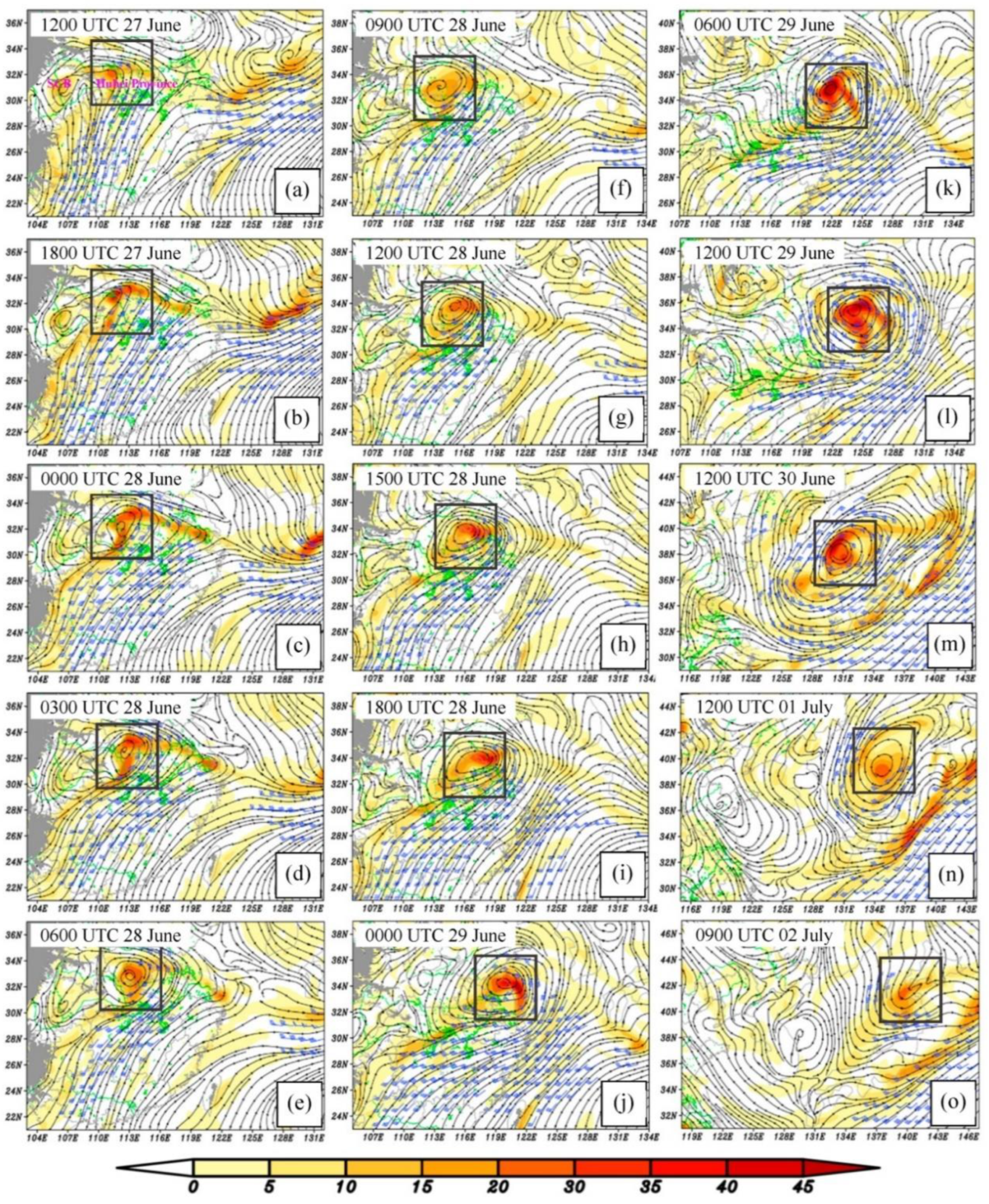
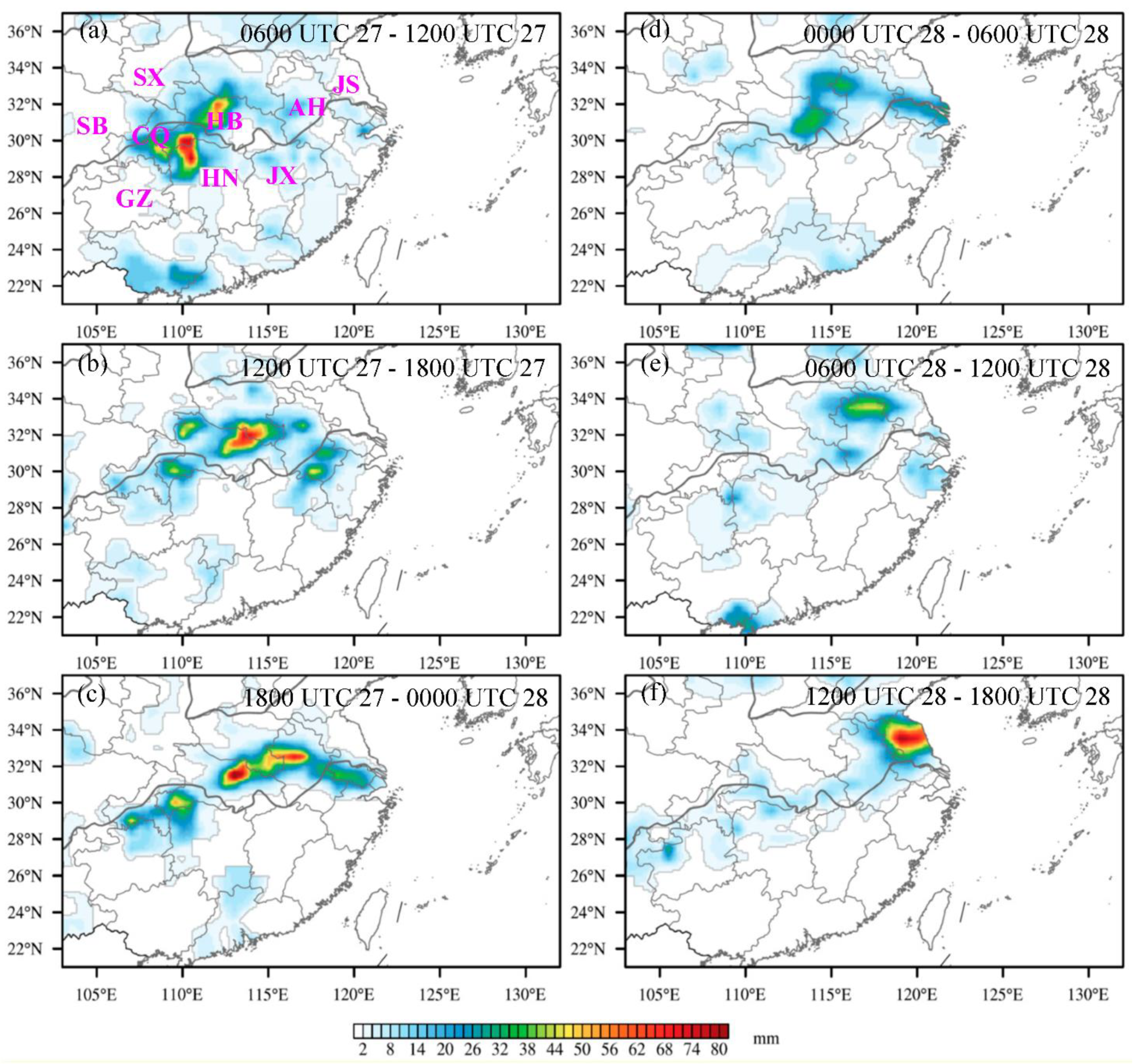
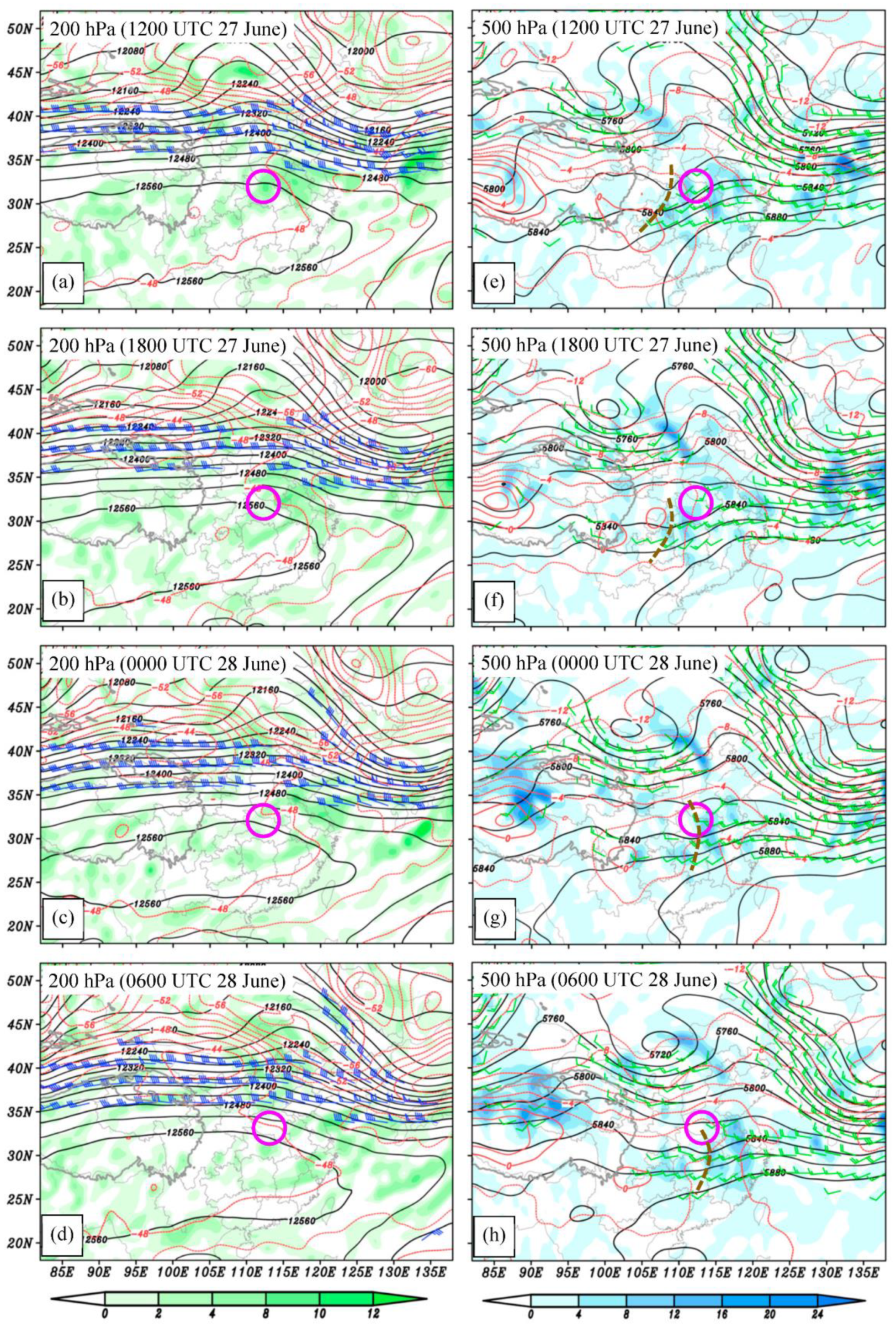
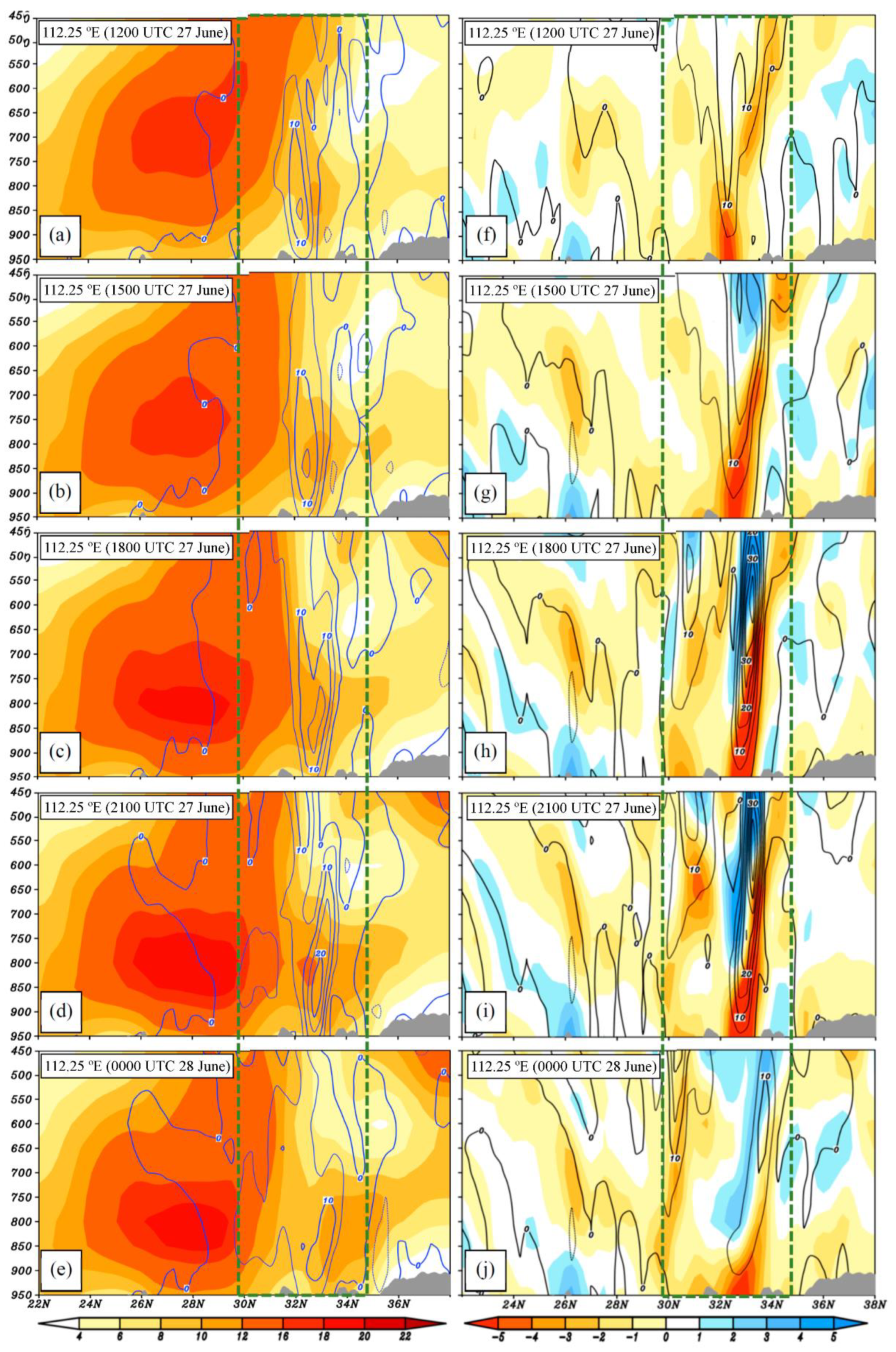

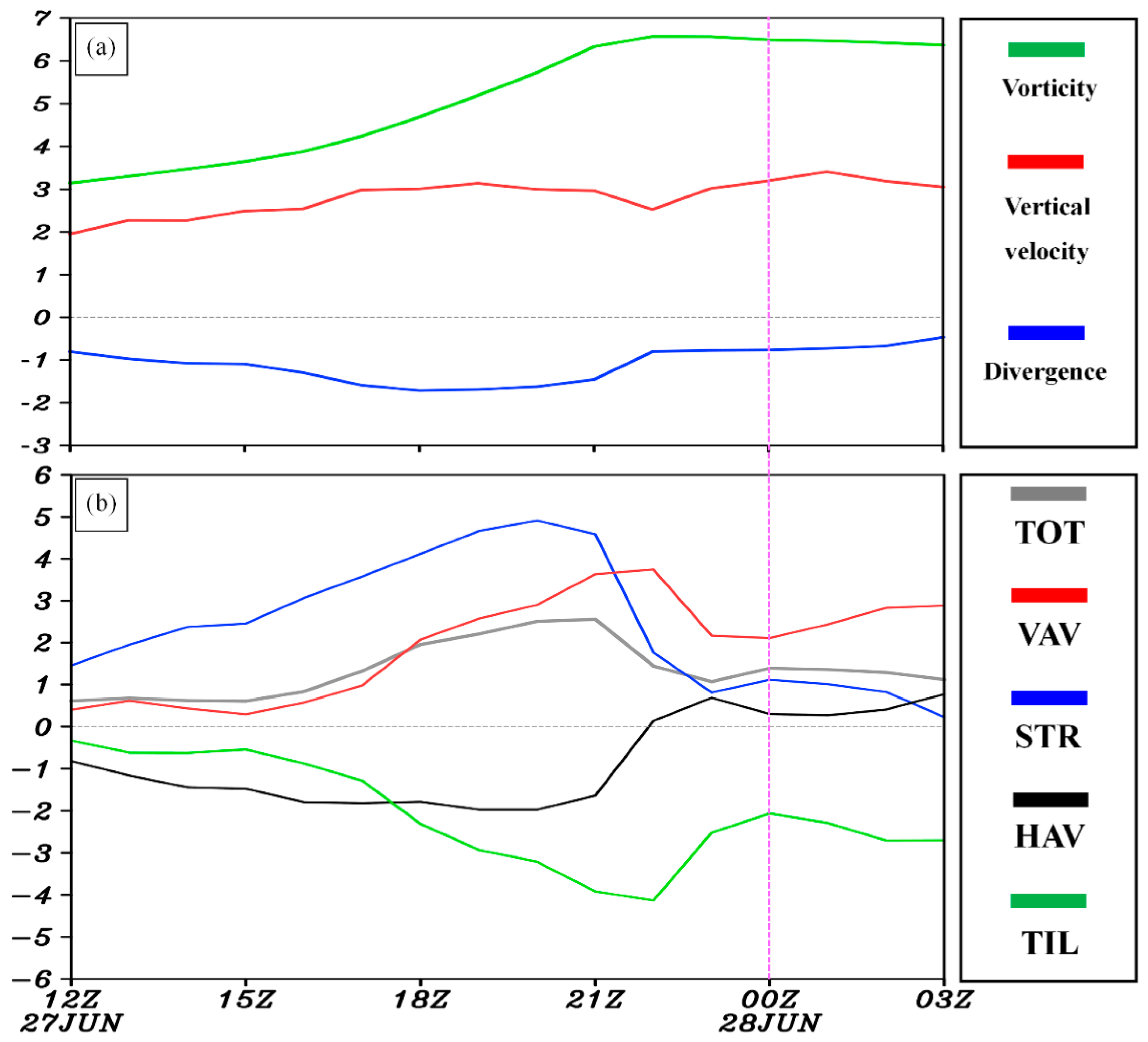



Publisher’s Note: MDPI stays neutral with regard to jurisdictional claims in published maps and institutional affiliations. |
© 2021 by the authors. Licensee MDPI, Basel, Switzerland. This article is an open access article distributed under the terms and conditions of the Creative Commons Attribution (CC BY) license (http://creativecommons.org/licenses/by/4.0/).
Share and Cite
Fu, S.-M.; Tang, H.; Li, Y.; Ma, H.; Sun, J.-H. On the Relationship of a Low-Level Jet and the Formation of a Heavy-Rainfall-Producing Mesoscale Vortex over the Yangtze River Basin. Atmosphere 2021, 12, 156. https://doi.org/10.3390/atmos12020156
Fu S-M, Tang H, Li Y, Ma H, Sun J-H. On the Relationship of a Low-Level Jet and the Formation of a Heavy-Rainfall-Producing Mesoscale Vortex over the Yangtze River Basin. Atmosphere. 2021; 12(2):156. https://doi.org/10.3390/atmos12020156
Chicago/Turabian StyleFu, Shen-Ming, Huan Tang, Yu Li, Hui Ma, and Jian-Hua Sun. 2021. "On the Relationship of a Low-Level Jet and the Formation of a Heavy-Rainfall-Producing Mesoscale Vortex over the Yangtze River Basin" Atmosphere 12, no. 2: 156. https://doi.org/10.3390/atmos12020156
APA StyleFu, S.-M., Tang, H., Li, Y., Ma, H., & Sun, J.-H. (2021). On the Relationship of a Low-Level Jet and the Formation of a Heavy-Rainfall-Producing Mesoscale Vortex over the Yangtze River Basin. Atmosphere, 12(2), 156. https://doi.org/10.3390/atmos12020156







